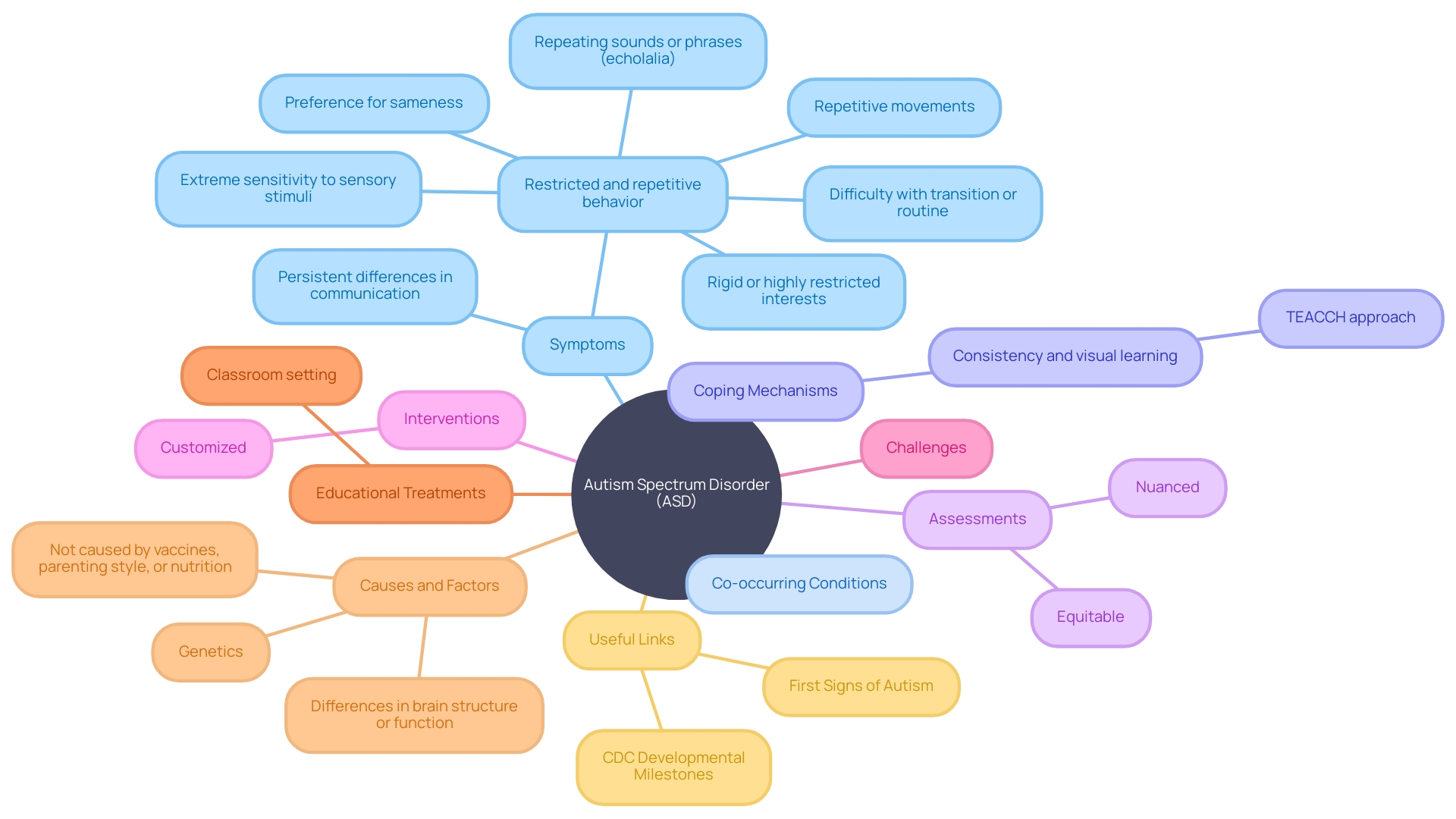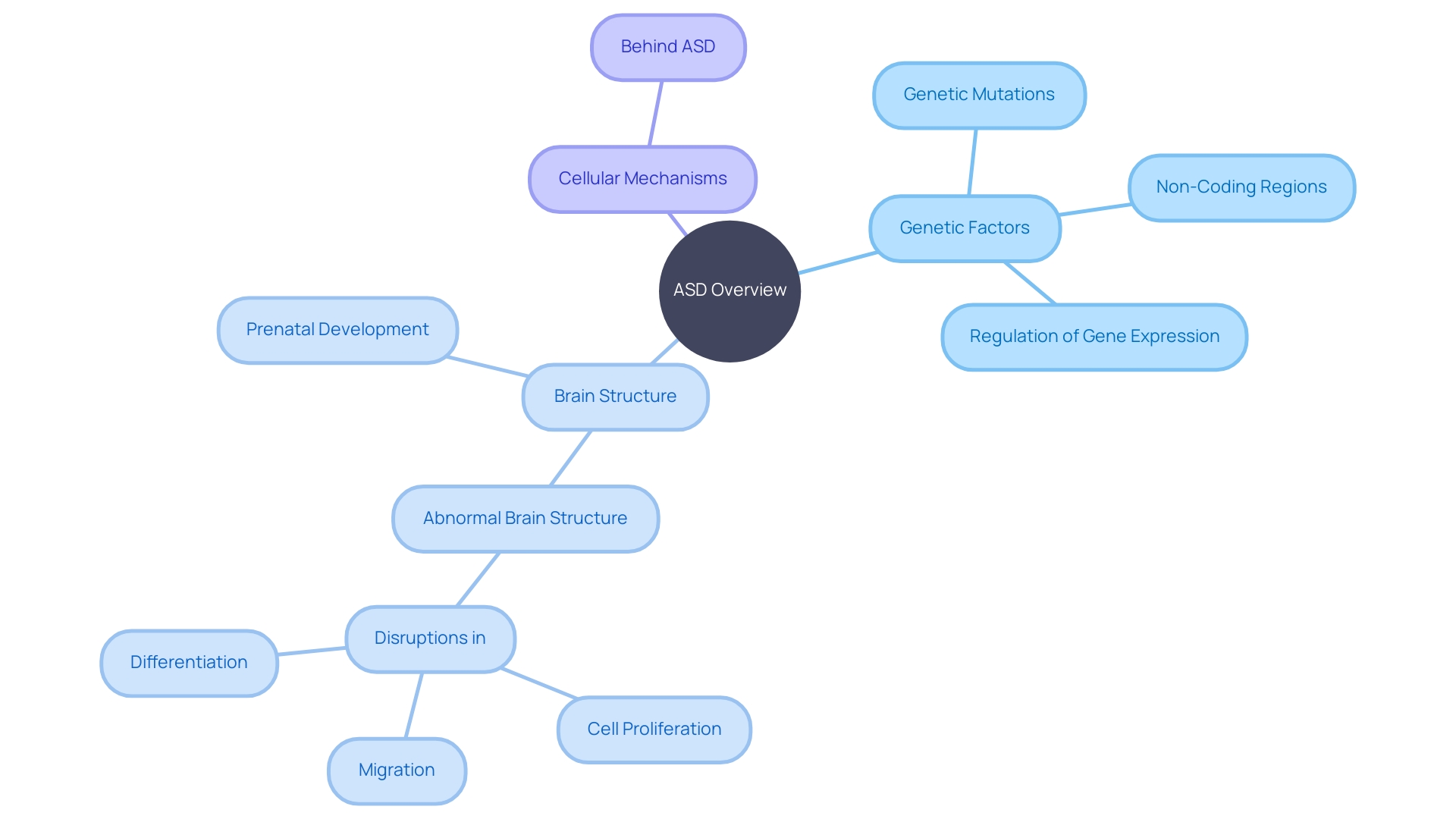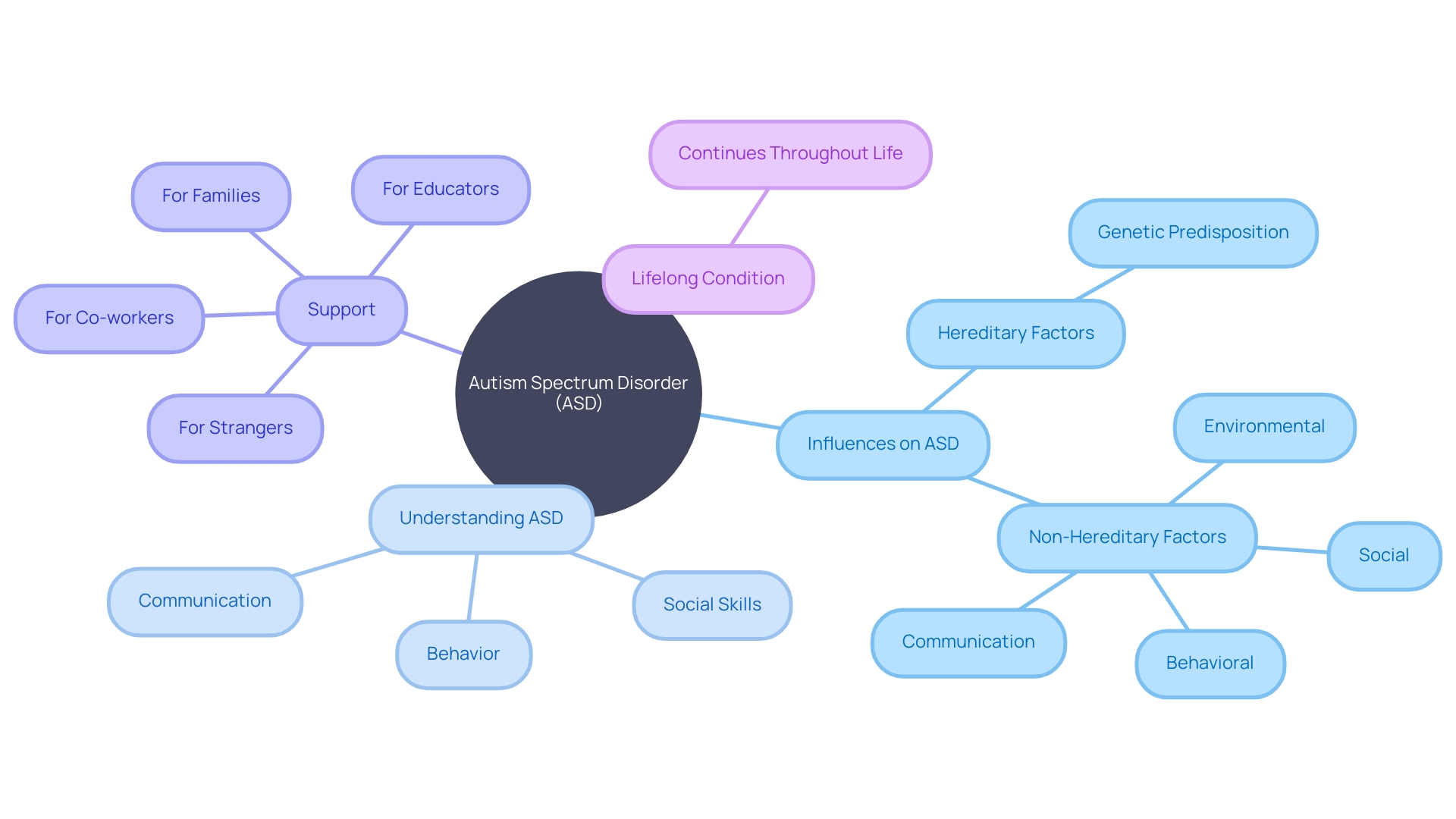Introduction
Autism spectrum disorder (ASD) is a complex condition influenced by a combination of genetic and environmental factors. As research continues to uncover the intricate genetic underpinnings of ASD, it becomes increasingly clear that understanding the interplay between genetics and the environment is crucial for developing effective interventions and support strategies. This article explores the latest findings in ASD research, highlighting the significance of genetic risk factors, specific genetic mutations, heritability, environmental risk factors, prenatal and perinatal exposures, air pollution, maternal health conditions, and the interactions between genetic and environmental factors.
By delving into these topics, researchers aim to empower parents and caregivers with the knowledge and resources needed to navigate the challenges of ASD and ensure the well-being of their children.
Genetic Risk Factors in Autism
Autism spectrum disorder (ASD) is a multifaceted neurodevelopmental condition with hereditary influences playing a pivotal role alongside environmental elements. Innovative research, backed by the National Institutes of Health under grant R01ES026993, continues to explore the intricate aspects that contribute to ASD. Ethical adherence and rigorous scientific standards underpin these studies, with approvals from entities like the Danish Data Protection Agency, ensuring patient anonymity and compliance with regulations.
One notable development in the field is the advent of tools such as Genotypes and Phenotypes in Families (GPF), innovated by scientists like Professor Iossifov. The GPF tool promises to shed light on the genetic underpinnings of the condition, potentially leading to significant breakthroughs in our understanding and management of the disorder. This groundbreaking approach showcases a thorough exploration from computational biology to a targeted analysis of ASD genetics, illustrating the progression and multidisciplinary character of research on developmental disorders.
From a historical point of view, when the condition was initially identified in 1943, the diagnostic criteria have since developed, resulting in a rise in prevalence rates. This rise is partly attributed to the broadened definition in the DSM-III-R, which encompassed a more comprehensive range of symptoms. Such changes highlight the dynamic nature of understanding ASD and the importance of ongoing research to refine our knowledge of this complex condition.

Specific Genetic Mutations and Variations Associated with Autism
Genetic factors play a significant role in the development of autism spectrum disorder (ASD), a condition marked by challenges in social interaction and repetitive behaviors. Recent discoveries indicate that the underpinnings of ASD are intricate, extending beyond the protein-coding regions of the genome. Research led by Atsushi Takata at RIKEN CBS has unveiled that new mutations, known as "de novo" gene variants, in non-coding areas of the genome, including promoters, may hold the key to understanding ASD's heritability. These regions regulate whether proteins are produced and are pivotal for gene expression control. This discovery is backed by one of the most comprehensive genome-wide studies involving over 5,000 families.
The human genome is a complex 3D entity where stretches of DNA can influence genes far from them when the molecule is coiled. These distant regulatory relationships are organized into topologically associated domains (TADs), where a promoter within one domain can control genes located elsewhere, illustrating the complexity of regulation in ASD.
Additional evidence supporting the basis of ASD, studies indicate an abnormal brain structure in children with the condition may be linked to disruptions in cell proliferation, migration, and differentiation during prenatal development. Notably, brain overgrowth observed in toddlers with autism suggests altered cell proliferation rates. Experiments with induced pluripotent stem cells (iPSCs) derived from individuals with ASD have shown varying proliferation rates and neuronal subtype determination impairments, offering a window into the cellular mechanisms behind ASD.
While the search for understanding continues, it is essential to acknowledge that approximately 1 in 100 children globally are diagnosed with ASD. With the majority of cases being idiopathic and polygenic, the exploration to fully comprehend ASD's inheritance landscape is ongoing. Still, current research provides invaluable insights into how hereditary and environmental factors may converge to shape this complex condition. As we discover more about the intricate aspects of ASD, families and medical professionals can better navigate the challenges of Autism Spectrum Disorder, fostering a more informed approach to support and interventions.

Heritability and Familial Risk of Autism
Autism spectrum disorder (ASD) is a complex condition where genetics play a pivotal role. Research indicates that if a family member has ASD, the likelihood of autism occurring in the family rises significantly, with heritability estimates suggesting a range from 50% to even 90%. Understanding the scope of familial risk is essential for identifying markers that could lead to personalized interventions. This aligns with the principle that every child deserves to participate fully and fairly in all aspects of life, a sentiment echoed by Dr. David (Dan) R. Offord, who emphasized equitable opportunities for children with disabilities. In accordance with this philosophy, scientists at Cold Spring Harbor Laboratory (CSHL) have developed the Genotypes and Phenotypes in Families (GPF) tool, which holds promise for uncovering the hereditary foundations of ASD. This research adheres strictly to ethical guidelines and has received the necessary approvals, ensuring the responsible advancement of knowledge in this field. As we decode the intricate fabric of autism, it becomes more and more evident that comprehending both parents' psychiatric histories is crucial, given the polygenic nature of mental health disorders. Recognizing the hereditary influences can empower caregivers and professionals to support the well-being and development of children with ASD, fostering an environment where every child can thrive fairly and fully in society.
Environmental Risk Factors in Autism
Autism Spectrum Disorder (ASD) is a intricate condition influenced by a tapestry of hereditary and non-hereditary factors. While the intricate genetic underpinnings of ASD are being unraveled, influences in the surroundings cannot be overlooked. These factors encompass a range of exposures, from those encountered prenatally to air pollution. One key concern is the potential impact of air contaminants, which have been implicated in various health issues including neurological disorders. Research suggests that being exposed to pollutants during crucial stages of development can increase the likelihood of developing a neurodevelopmental disorder. This connection emphasizes the significance of comprehending and mitigating risks related to the surroundings as part of a comprehensive approach to addressing ASD. It's crucial to consider the breadth of these factors, as well as their interactions with individual genetics, to fully grasp the etiology of this condition and to guide families towards effective interventions and supports.

Prenatal and Perinatal Environmental Exposures
Investigating the link between factors in the surroundings and autism, recent studies emphasize the importance of prenatal and perinatal exposures in the potential rise of autism risk. Notably, maternal infections during pregnancy, certain medications, and complications during birth have been identified as contributing elements. These factors operate through a complex network, including dietary intake, pollution, stress, and substance use, that may affect DNA within placental and fetal tissues. The impacts of these exposures can be profound, with an epidemiological study showing that about 1 in 54 children in the United States are diagnosed with ASD.
A crucial aspect of this research is comprehending how these exposures are assessed, often involving sophisticated methods such as questionnaires, spatial sensors related to residential history, and the analysis of exposure biomarkers found in blood and urine samples. As the global prevalence of ASD hovers around 1%, researchers are delving into the socio-economic challenges it poses, including lifelong care needs and the integration of affected individuals into society. Air pollution, specifically, has been under scrutiny for its links to a wide range of adverse health outcomes, including neurological diseases. Transitioning from polybrominated diphenyl ether flame retardants to organophosphate esters in various products has raised concerns about the potential toxicity and impact on fetal development.
Against the backdrop of these findings, a significant $5 million study funded by the NIH is set to investigate the impact of external factors on child health, including disabilities. This study is part of the larger Environmental influences on Child Health Outcomes (ECHO) Program, aiming to provide a clearer picture of how a pregnant person's surroundings, diet, stress, and medications contribute to their child's health trajectory. The investigation into factors pertaining to the environment is not just about immediate exposures; it encompasses a broad spectrum of influences, some of which are transient and difficult to quantify due to their elusive nature.
The research is conducted with rigorous ethical guidelines, necessary approvals, and participant consents, emphasizing that the findings represent the authors' efforts and are not necessarily the NIH's official views. This level of diligence ensures that the data collected is both credible and respectful of the participants' privacy. As the pursuit to unravel the complexities associated with ASD continues, it remains clear that a multifaceted approach is essential to develop effective strategies to mitigate the potential risks linked to exposures during the prenatal and perinatal periods.
Air Pollution and Other Environmental Toxins
The complex connections between pollutants and human health have come under growing scrutiny, with recent studies shedding light on the potential impact of air pollution on the brain's development and function. Notably, the inhalation of fine particulate matter, specifically PM2.5, and heavy metals present in polluted air may influence the onset of autism spectrum disorder (ASD) when exposure occurs during pivotal developmental windows such as pregnancy and early childhood. This growing body of research, however, is still in its nascent stages, necessitating further exploration to elucidate the mechanisms that underpin this correlation.
A study published in the journal Neurology uncovered that individuals subjected to elevated levels of PM2.5 prior to their demise exhibited increased amyloid plaques in their brains, a hallmark of Alzheimer's disease. Interestingly, this connection remained valid even for individuals without a genetic inclination towards Alzheimer's, suggesting the wider impact of external factors in neurological disorders.
In the realm of education, a comprehensive study tracking the academic journey of 2.8 million students in North Carolina yielded compelling evidence that air pollution, particularly PM2.5, adversely affects cognitive performance. This investigation, leveraging a robust dataset, underscores the significance of air quality on children's academic outcomes and suggests a possible link to developmental disorders such as ASD.
The detrimental effects of air pollution extend beyond cognitive impairments. A meta-analysis of 110 studies involving over 18 million stroke cases revealed that exposure to a variety of pollutants, including nitrogen dioxide and varying sizes of particulate matter, was associated with a heightened risk of stroke.
These findings resonate with the broader consensus on the health hazards posed by air pollution. A quote capturing the essence of this concern states, 'Air pollution is a familiar health hazard... It is a major threat to global health and prosperity.' The quote emphasizes that air pollution, through its myriad hazardous substances, can affect almost every organ in our bodies, with the respiratory tract serving as the primary entry point for these pollutants.
Statistics reinforce the gravity of this global issue, with air pollution contributing to an array of diseases and premature deaths. The AirQ+ software, developed to assess the health impacts of air quality measures, has been deployed in over 300 cities since 2016, reflecting the widespread acknowledgment of the need to address air pollution.
As research continues to untangle the complex interactions between air pollution and neurodevelopmental disorders, it becomes increasingly clear that a multifaceted approach encompassing environmental, health, and educational perspectives is required to safeguard the well-being of current and future generations.
Maternal Health Conditions and Autism Risk
Research has found a connection between specific maternal health conditions and an increased likelihood of offspring developing a neurodevelopmental disorder. Significant health concerns during pregnancy, like gestational diabetes, obesity, and specific autoimmune disorders, are now recognized as factors that could potentially elevate the likelihood of developmental disorder in children. These findings are essential for developing effective early intervention and prevention strategies, and they underscore the importance of optimal maternal health for the future well-being of offspring. A comprehensive study approved by the Danish Data Protection Agency highlighted the association between higher maternal autistic traits and increased risks of preterm birth. Recognizing the intricacy of these factors can open up possibilities for more nuanced approaches to maternal healthcare and research on neurodevelopmental conditions.
Interactions Between Genetic and Environmental Factors
The complex interplay between inherent tendencies and external influences is vital in the formation of autism spectrum disorder (ASD). Instead, genetics may shape how an individual reacts to various factors in the surroundings. A study approved by the Danish Data Protection Agency, emphasizing adherence to ethical guidelines, showcases the importance of considering both innate hereditary risks and external influences in understanding ASD.
For instance, groundbreaking research using the SPARK database, consisting of data from around 30,000 individuals, utilized machine learning models to detect ASD patterns. The Media model, in particular, successfully identified ASD in approximately 80% of children by examining a set of parameters available before the age of 24 months. This includes factors such as the age of first smile and the presence of eating difficulties, highlighting the potential for early intervention.
Despite the progress in research on genes, comprehending the non-genetic aspect stays a challenge. The fleeting nature of exposures, varying from prenatal infections to socioeconomic factors, complicates the task of pinpointing their exact role in ASD. The intricacy of these interactions highlights the need for ongoing research, as stressed by scientists at Cold Spring Harbor Laboratory, who are tirelessly working to unravel the hereditary and external factors of autism.
With ASD's prevalence on the rise, partly due to evolving diagnostic criteria, the merging of hereditary insights and environmental understanding becomes even more critical. The collaborative efforts of researchers, supported by comprehensive ethical research practices, aim to unravel the complexities of ASD, offering hope for more effective interventions and support for affected individuals and their families.
Current Research and Future Directions in Understanding Autism
Autism Spectrum Disorder (ASD) presents a complex challenge for researchers due to its diverse manifestations and intricacies. The condition can range from significant impairments in social interaction and communication to high-functioning individuals with distinctive abilities. Despite these variations, researchers like Professor Iossifov at Cold Spring Harbor Laboratory (CSHL) are dedicated to uncovering the underlying genetic factors of autism. His development of the Genotypes and Phenotypes in Families (GPF) tool is a testament to the innovative strides being taken in the field. The GPF tool not only facilitates the comprehension of ASD's roots but also paves the way for uncovering future markers that contribute to the disorder.
Through careful ethical compliance and oversight, such as the approval by the Danish Data Protection Agency for studies without the need for informed consent due to their register-based nature, the integrity of research is maintained. This ensures that all patient and participant data remain confidential, as mandated by stringent guidelines.
Recognizing the hereditary aspects of this condition is not just about identifying particular genes but also about how these genes interact with exposures in the surroundings. The complexity in quantifying factors, as highlighted by the difficulty in tracking exposures such as air quality or prenatal pathogen exposure, adds to the complexity of this research. These factors are often transient and can range widely, making it difficult to assess their full impact.
Nevertheless, the commitment to advancing our knowledge in this area is unwavering. The National Institutes of Health (NIH) supports this endeavor, as illustrated by the curated list of human genes linked to psychiatric illnesses available on the NIMH website. This list includes genes with strong statistical support for association with mental health traits, focusing on rare variations that align with NIMH priorities for genomics research.
As research progresses, the potential for discovering new interventions and therapies grows. The hope is that with continued exploration of both genetic and environmental factors, a more comprehensive understanding of autism will emerge, leading to better support and improved quality of life for those affected by ASD and their families.
Conclusion
In conclusion, understanding the interplay between genetics and the environment is crucial for effectively supporting individuals with autism spectrum disorder (ASD). Genetic research has uncovered intricate genetic underpinnings, including new mutations in non-coding areas of the genome and the role of distant regulatory relationships. Heritability studies emphasize the importance of considering both parents' psychiatric histories.
Environmental factors, such as air pollution and prenatal exposures, also contribute to ASD risk. The interactions between genetic and environmental factors are complex, and ongoing research aims to unravel their intricacies.
The fusion of genetic insights and environmental understanding is necessary to navigate the challenges of ASD and provide effective interventions and support. The development of innovative tools, like the Genotypes and Phenotypes in Families (GPF) tool, showcases researchers' dedication to uncovering the genetic layers of autism. By empowering parents and caregivers with knowledge, we can ensure the well-being of individuals with ASD.
As research progresses, the hope is to discover new interventions and therapies that improve the quality of life for individuals with ASD. Understanding the intricate interplay between genetics and the environment enables us to develop informed strategies and foster a society where every child can thrive fully and fairly.




